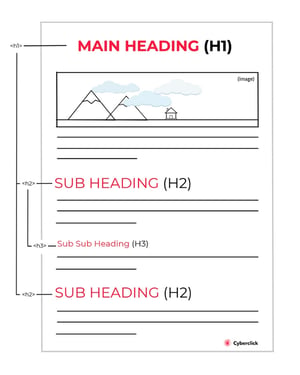When talking about on-page SEO, we often focus on techniques used to optimize headlines, meta descriptions, or content. But there is something else that can have a big impact on your website’s positioning on search engines: the URL structure and site map.
Creating a cohesive web structure with well-organized links not only makes it easier for search engines to understand your content, but it also helps users locate information more easily and have a better user experience. So let's look at how to improve your URL structure by using pillar pages and clusters.

URL Structure and SEO
When people surf the Internet, they’re looking to seamlessly navigate through a website. They’re not alone because Google's algorithms are also paying attention to user experience and ease of navigation.
You want search engines like Google to analyze all the content on your website quickly and easily, which requires structuring the information very well, creating different levels of depth, and making it understandable to Google's algorithm. much of this work is based on a good URL structure.
The URL is the address of a specific page of a website. There cannot be repeated URLs within the same website (or anywhere else on the Internet) as they are unique identifiers. The contents of each URL should also be unique, otherwise Google will understand that it is duplicate content and will penalize it.
Within every URL there two main parts.
- The fixed part or domain of the site. For example, in our case it would be:
www.cyberclick.net
- The customizable part of each page. Ideally, it should describe the content of the page as clearly as possible, through keywords separated by short hyphens and without superfluous elements. For example:
www.cyberclick.net/inbound-marketing
is better than www.cyberclick.net/inboundmarketingeverythingyouneedtoknow
In order to define the architecture of your website, first create a homepage and then branch out by creating different pages and levels. Continuing with the previous example, we could have the following:
- First level: the home page.
www.cyberclick.net
- Second level: the Cyberclick services section.
www.cyberclick.net/services
- Third level: each of the pages dedicated to a particular service.
www.cyberclick.es/services/video-marketing
This way, the URLs are telling search engines how the information within your website is structured. These types of URLs are also easier for users to remember.
How to Create a Silo Architecture With Pillar Pages and Clusters
For a long time now, in the world of SEO and inbound marketing silo architecture has been the best way to organize a website. The basic idea is to create one or several pillar pages dedicated to large concepts related to your industry. Each pillar page will link to different clustered articles with secondary content that expands on the main topic. This main page and secondary content are connected through links and reinforce each other to position themselves better on Google.
Pillar Pages
Each pillar page is a piece of content that focuses on the main keyword you want to position for. It seeks to explain the different points within a broad subject. Each of these points is then developed through other, shorter pieces of written content, videos or infographics that support the pillar page.
For example, Cyberclick has a pillar page dedicated to SEO. The secondary content (also called content cluster) is this article. In the pillar page, we explain the broad, basic principles of SEO, and we using this article to get more granular and explain a certain topic in more detail.
There is some debate about how long written content has to be, but the truth is that there are no magic numbers like 500, 3,000 or 10,000 words. So how long should main vs secondary content be?
Search for the keyword in question on Google and look at the average length of the content that is positioned on the first page. If you see that on the first page most of the content is limited to 500 words, you just need to go a little bit beyond that. In other more competitive sectors, you may see that the content is much more extensive, but the same rule applies: you just have to go a bit further than the average.
There is no exact science. You may find that a 3,000 word article is in the second position for a given keyword while a 1,000 word article is in the first position.
Content Clusters
Content clusters (also called topic clusters) are a series of articles that delve into different aspects related to the pillar page. For example, you can have a pillar page about content marketing and cluster pages about content marketing in social networks (which would rank for a long tail keyword) and about guest authors (a related keyword).
The idea of a content cluster is to provide value to the user and add weight to the pillar page through links. Thus, you create a silo or cluster around the main keyword to reinforce it and position it above the competition.
Continuing with the previous example, a pillar page on content marketing could have an H1 entitled "What Is Content Marketing" and within it, an H2 with a definition (without a derivative article) and another H2 on inbound content marketing (which links to an article in the cluster on that topic).

As for the length of the content in the cluster, it should be shorter than the main page. If your pillar page has 3,000 words, 1,000 or 1,500 may be enough.
Finally, the link structure organizes this content and helps users and search engines understand the relationship between the pages. The pillar page should link to all the sub-articles and vice versa. Content from different sources can also be included if they are related, for example, a YouTube video or an article from another section. This is not an exact science, so experiment and find out what works best for your website!
Responsable de la estrategia de contenidos y visibilidad en Cyberclick, con enfoque Allbound y especialización en posicionamiento SEO, GEO y automatización con IA. Gestión avanzada del CRM con HubSpot: base de datos, workflows, lead nurturing, scoring y reporting. Experiencia en marketing digital, comunicación corporativa y periodismo, uniendo estrategia, creatividad y tecnología para captar y convertir leads cualificados.
Responsible for content and brand visibility strategy at Cyberclick, with an Allbound approach and specialization in SEO, GEO (Generative Engine Optimization), and AI-powered automation. Advanced HubSpot CRM management: database segmentation, workflows, lead nurturing, scoring, and reporting. Background in digital marketing, corporate communications, and journalism—combining strategy, creativity, and technology to attract and convert qualified leads.






Leave your comment and join the conversation